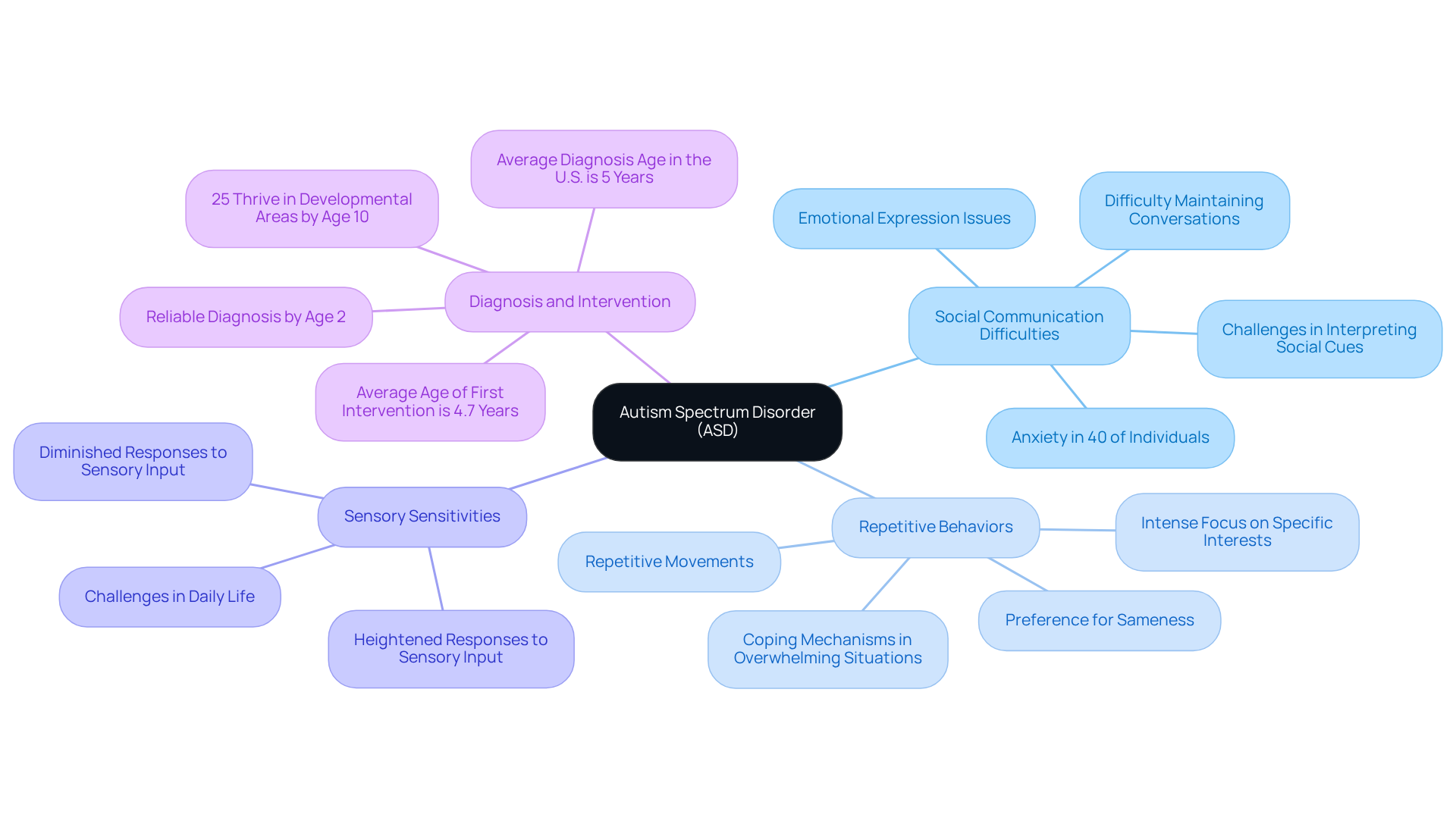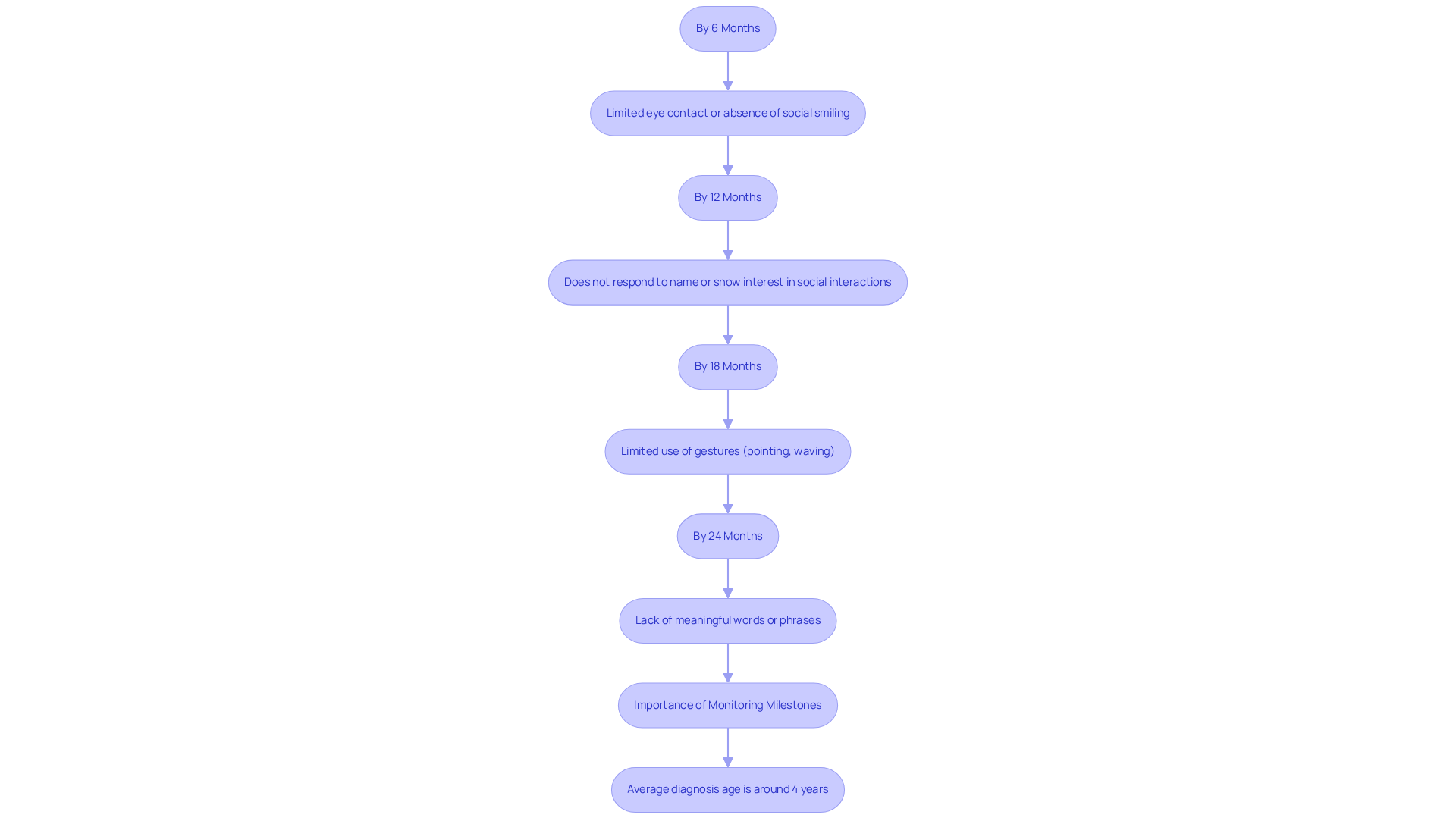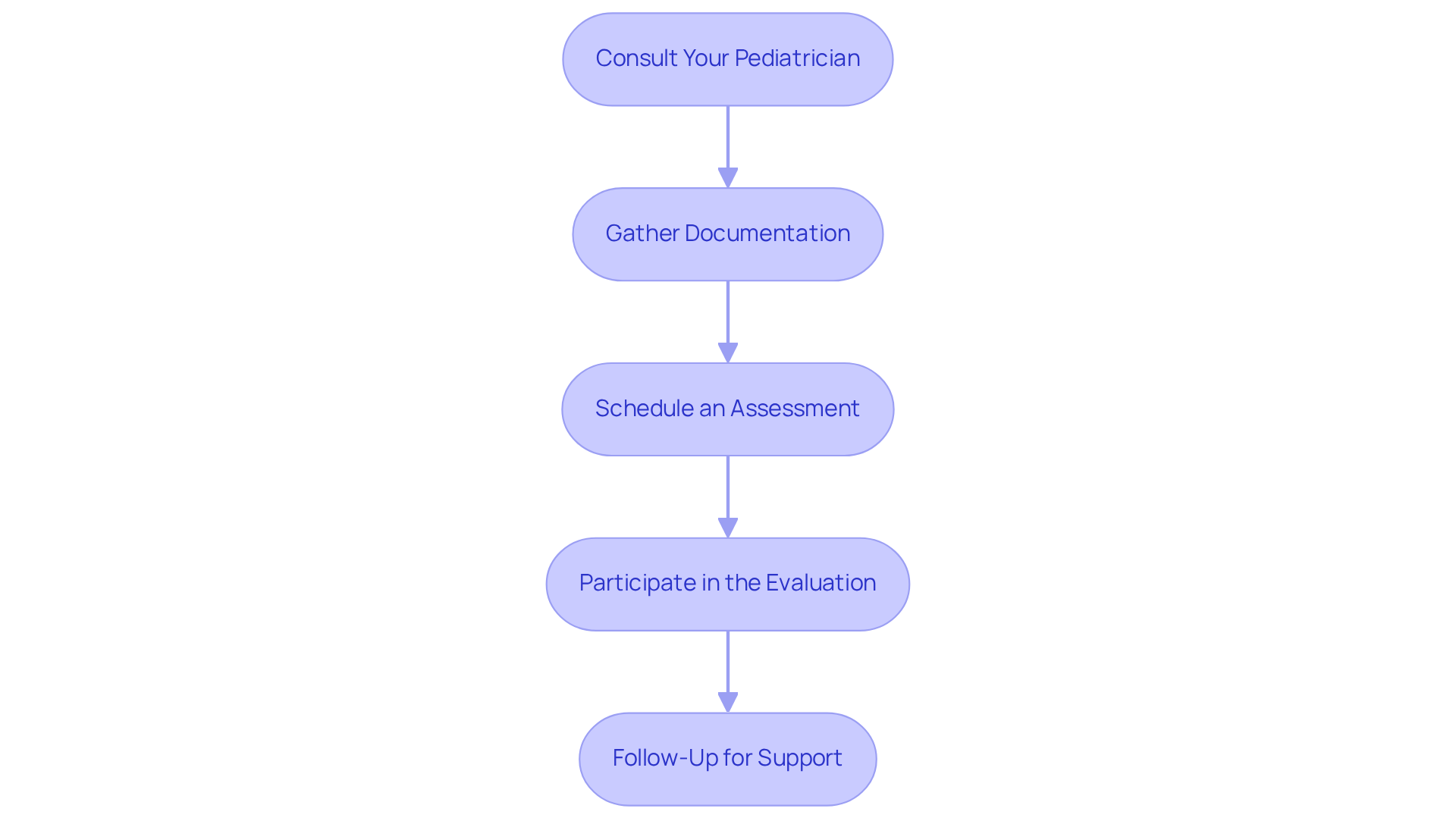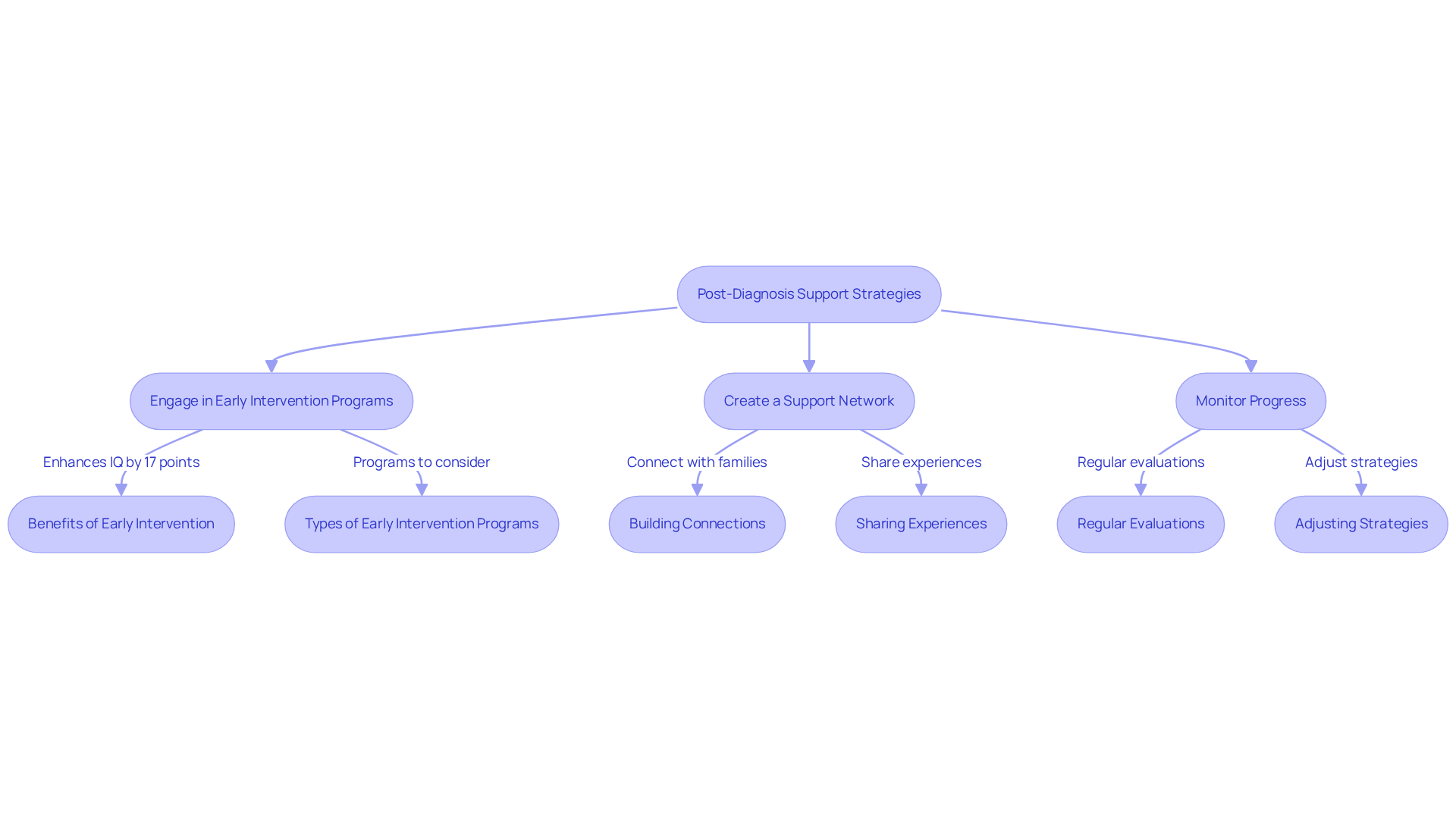Overview
Understanding when autism can be diagnosed is a crucial concern for many parents. While reliable diagnoses can be made by age 2, it’s important to note that the average age of diagnosis in the U.S. is around 5 years. This delay can be disheartening, but recognizing key developmental milestones early on can make a significant difference. Early identification is not just beneficial; it can profoundly improve outcomes for children with Autism Spectrum Disorder (ASD).
As parents, being aware of these milestones allows you to advocate for your child effectively. It’s natural to feel overwhelmed, but remember, you are not alone in this journey. Many families face similar challenges, and sharing experiences can provide comfort and insight. Consider reaching out to local support groups or online communities where you can connect with others who understand your situation.
Taking action now can lead to better support and resources for your child. By prioritizing early identification, you are taking a vital step toward ensuring your child receives the help they need to thrive. Together, we can foster a nurturing environment for all children with ASD, empowering them to reach their full potential.
Introduction
Understanding Autism Spectrum Disorder (ASD) is essential for parents as they navigate the complexities of their child's development. The potential benefits of early intervention are significant, making it crucial to recognize the signs and understand when a diagnosis can be made.
However, many parents find themselves wondering about the specific age milestones for autism diagnosis and the steps needed to obtain an evaluation.
How can caregivers ensure they are proactive in seeking the right support at the right time? Your journey toward understanding ASD can be filled with questions, but you are not alone. Together, we can explore the resources and support available to help you every step of the way.
Understand Autism Spectrum Disorder: Definition and Characteristics
Autism Spectrum Disorder (ASD) is a developmental disorder that presents persistent challenges in social communication, restricted interests, and repetitive behaviors. Understanding these characteristics is crucial for parents and caregivers who want to support their children effectively.
- Social Communication Difficulties: Children with ASD often struggle to interpret social cues, maintain conversations, and express their emotions. It’s important to note that around 40% of individuals with ASD experience anxiety, which can complicate social interactions (National Survey of Children’s Health). Recognizing these difficulties can help parents create a supportive environment for their children.
- Repetitive Behaviors: These behaviors may appear as repetitive movements, a strong preference for sameness, or an intense focus on specific interests. For many young individuals, these actions serve as coping mechanisms in overwhelming situations. Understanding this can foster patience and compassion in caregivers.
- Sensory Sensitivities: Many children with ASD exhibit heightened or diminished responses to sensory input, such as sounds, lights, or textures. These sensitivities can create challenges in daily life, affecting their ability to interact with peers and their surroundings. Acknowledging these experiences can help parents navigate social situations more effectively.
Recognizing these characteristics early is vital for parents and professionals to understand at what age can you diagnose autism, as it allows for timely evaluation and support. While autism can be reliably diagnosed by a specialist by age 2, many wonder at what age can you diagnose autism in the U.S., where the average age of diagnosis is around 5 years. Additionally, the average age of first involvement in services is 4.7 years. Early recognition can significantly enhance outcomes, enabling young individuals to access essential assistance and support services.
Remarkably, nearly 25% of school-age individuals with autism thrive in all developmental areas by the age of 10. This statistic underscores the positive impact of early identification and intervention. If you suspect your child may have ASD, consider reaching out to a specialist for guidance. Your proactive steps can make a world of difference in their development and well-being.

Recognize Key Age Milestones for Autism Diagnosis
Recognizing key age milestones is crucial for understanding at what age can you diagnose autism and identifying potential signs of the condition. These milestones can serve as essential indicators for parents to watch for:
- By 6 Months: You may notice limited eye contact or an absence of social smiling.
- By 12 Months: Your little one might not respond to their name or show interest in social interactions.
- By 18 Months: There could be a limited use of gestures, such as pointing or waving.
- By 24 Months: A lack of meaningful words or phrases is often observed.
While some children display signs earlier, many do not receive a diagnosis until after age 3, prompting parents to wonder at what age can you diagnose autism. In fact, at what age can you diagnose autism is currently around 4 years. This highlights the importance of monitoring these milestones closely. Recent recommendations from youth development experts emphasize the need for careful observation and prompt assessment. Early identification can significantly improve outcomes for children. Statistics reveal that around 3.2% of youths aged 8 years have been identified with autism, and importantly, 1 in 36 young individuals in the US have received a diagnosis. This underscores the necessity of proactive monitoring and support for our children.

Follow the Diagnostic Process: Steps to Obtain an Autism Evaluation
To obtain an autism evaluation, it’s important to navigate the process with care and understanding. Here are some essential steps to guide you:
-
Consult Your Pediatrician: Start by sharing your concerns and observations about your child's development with your pediatrician. They can perform initial screenings and refer you to specialists who can help. Many parents find comfort in knowing that pediatricians are key players in this process, with a significant number relying on their guidance.
-
Gather Documentation: Collect important records, such as developmental milestones, behavioral observations, and any past assessments. Research shows that around 70% of parents take the time to gather this documentation before seeking an assessment, which can help ensure a thorough review of your child's needs.
-
Schedule an Assessment: Work together with a specialist, like a developmental pediatrician or psychologist, to set up a comprehensive assessment. This process often includes interviews, questionnaires, and direct observation of your child. Specialists recommend that these assessments be thorough to ensure an accurate diagnosis and effective treatment. It’s worth noting that the average age for initial intervention for autism in the U.S. prompts the inquiry at what age can you diagnose autism, highlighting the importance of timely assessments.
-
Participate in the Evaluation: Be ready to discuss your child’s behavior and development. The assessment might involve standardized tests to evaluate communication, social skills, and behavior. Developmental pediatricians stress the importance of your input during this stage, as it offers valuable context for understanding your child's unique needs. According to the CDC, 26.7% of individuals with a spectrum condition experience profound symptoms, underscoring the necessity of comprehensive evaluations.
By following these steps, you can help ensure a thorough assessment and accurate diagnosis, paving the way for effective support and assistance for your child. Remember, you’re not alone in this journey, and seeking help is a courageous step towards understanding and supporting your child's needs.

Implement Ongoing Support and Assessment Strategies Post-Diagnosis
Receiving an autism diagnosis can be a pivotal moment for families, leading them to wonder at what age can you diagnose autism, often filled with a mix of emotions and concerns. It’s essential to know that there are effective strategies available to support your child’s ongoing development and well-being.
-
Engage in Early Intervention Programs: Early intervention is not just important; it’s vital. Studies reveal that children who receive such support can enhance their IQ by an average of 17 points. Programs that focus on communication, social skills, and behavioral strategies can lead to significantly better developmental outcomes. Moreover, early intervention can save an estimated $1.3 million per child over their lifetime, showcasing its profound economic benefits.
-
Create a Support Network: Building connections with other families, support groups, and professionals who understand autism can be incredibly beneficial. Research shows that over 80% of families experience an improved quality of life and reduced stress after joining support networks. Sharing experiences can provide invaluable emotional support and practical advice. Experts emphasize that establishing a robust support network is crucial for navigating the challenges that autism presents, especially in understanding at what age can you diagnose autism.
-
Monitor Progress: Regular evaluations of your child’s development are essential. This may involve ongoing assessments to adjust strategies and approaches as their needs evolve. Early support programs have shown that children can achieve significant improvements in cognitive skills and adaptive behavior over time. For instance, Ethan, a young participant in an ABA-based early support program, remarkably decreased his tantrums by 70% and significantly improved his communication skills.
Educate yourself about at what age can you diagnose autism, as staying informed about developmental disorders and available resources empowers you to advocate effectively for your child’s needs. Understanding effective strategies and support options can amplify the positive impact of interventions. Experts highlight that knowledgeable parents are better equipped to navigate the complexities of developmental disorders and meet their child’s needs.
By implementing these strategies, you can help your family navigate the complexities of autism, creating a nurturing environment that fosters your child’s growth and development. Remember, you are not alone on this journey—there are resources and communities ready to support you every step of the way.

Conclusion
Understanding the age at which autism can be diagnosed is crucial for ensuring timely support and intervention for children with Autism Spectrum Disorder (ASD). Recognizing the signs and characteristics of ASD early on empowers parents and caregivers to seek evaluations and access necessary resources, ultimately enhancing developmental outcomes for their children.
This article highlights the significance of understanding key age milestones for autism diagnosis, from limited eye contact at six months to the absence of meaningful words by age two. It emphasizes the importance of navigating the diagnostic process effectively, starting with consultations with pediatricians and gathering relevant documentation. Furthermore, implementing ongoing support strategies post-diagnosis, such as engaging in early intervention programs and building a support network, can significantly improve the quality of life for families dealing with autism.
The journey of understanding and supporting a child with autism is filled with challenges, yet it also presents an opportunity for growth and connection. By staying informed and proactive, families can create an environment that fosters their child's development and well-being. It is essential to monitor progress continuously and advocate for the necessary resources, ensuring that every child has the opportunity to thrive. The steps taken today can lead to a brighter future for children with autism, making awareness and early intervention paramount in this journey.
Frequently Asked Questions
What is Autism Spectrum Disorder (ASD)?
Autism Spectrum Disorder (ASD) is a developmental disorder characterized by persistent challenges in social communication, restricted interests, and repetitive behaviors.
What social communication difficulties do children with ASD face?
Children with ASD often struggle to interpret social cues, maintain conversations, and express their emotions. Additionally, around 40% of individuals with ASD experience anxiety, which can complicate social interactions.
What are common repetitive behaviors associated with ASD?
Common repetitive behaviors in children with ASD may include repetitive movements, a strong preference for sameness, and an intense focus on specific interests. These behaviors often serve as coping mechanisms in overwhelming situations.
How do sensory sensitivities affect children with ASD?
Many children with ASD have heightened or diminished responses to sensory input, such as sounds, lights, or textures. These sensitivities can create challenges in daily life and affect their ability to interact with peers and their surroundings.
At what age can Autism Spectrum Disorder be diagnosed?
Autism can be reliably diagnosed by a specialist by age 2. However, the average age of diagnosis in the U.S. is around 5 years, with the average age of first involvement in services being 4.7 years.
What is the importance of early recognition of ASD?
Early recognition of ASD is vital as it allows for timely evaluation and support, which can significantly enhance outcomes for young individuals. Nearly 25% of school-age individuals with autism thrive in all developmental areas by the age of 10 due to early identification and intervention.
What should I do if I suspect my child may have ASD?
If you suspect your child may have ASD, it is advisable to reach out to a specialist for guidance. Proactive steps can make a significant difference in their development and well-being.




